Mark Amerika, founding editor of ebr, discusses the early days of Altx, Black Ice, and the birth of digital literary networks.
Scott Rettberg reflects on founding the ELO and the literary networks that shaped early digital writing.
Steve Tomasula on postmodern storytelling, collaboration, and open-access publishing in the digital age.
Rob Wittig discusses netprov, improvisation, and how ebr fosters experimental expression.
Ewan Branda shares how design computation shaped ebr’s shift to dynamic, database-driven publishing.
Davin Heckman recalls tacos with Joe Tabbi and how ebr became a hub for digital narrative and community.
Lori Emerson talks about material media and her roots in experimental poetics.
Lai-Tze Fan and Joe Tabbi trace editorial lineages and the formative exchanges that animate ebr.
Will Luers discusses removing the technical barriers to open-access publishing, allowing a community of editors to focus on editorial work.
Anna Nacher recounts feminist foundations, digital culture, and theorizing beyond the platform.
Tegan Pyke reflects on archival research and highlighting women’s contributions to ebr's formative years.
Joe Tabbi, co-founder of ebr, reflects on its inception, and in the other interviews contributes to the story of the journal's evolution, and future trajectories.
"A Review of Books in the Age of Their Technological Obsolescence"
Tabbi inaugurates ebr by interrogating the so-called “death of the book” in the digital age, suggesting not an end but a shift in how books are read and contextualized. He sees digital media not as a threat but as an opportunity to rethink literary culture. Drawing on Sterling and Powers, he argues for coexistence between print and digital forms. ebr is posed as a hybrid field site for these new literacies.
"Notes from the Digital Overground"
Amerika charts his path from underground outsider to digitally networked author, grappling with the contradictions of artistic resistance inside systems of capital. Through Alt-X and digital publishing, he explores how creative work can build new communities even while entangled in corporate infrastructures. He remains wary of commodification but insists on critical engagement. The essay mixes memoir and manifesto for literary insurgency in networked space.
"A Project for a New Consultancy"
Ulmer and Tabbi propose “electracy” as a new literacy for digital culture, replacing academic critique with playful, collaborative reinvention. They advocate for “reinviews” over traditional interviews, arguing for intellectual engagement as public, networked, and affect-driven. Ulmer’s popcycle model weaves family, entertainment, school, and discipline into new forms of thought. The dialogue models the digital consultancy they envision.
"Joseph McElroy: Fathoming the Field"
Wilson explores McElroy’s fiction as “field-based,” where meaning arises from interdependencies rather than heroic plotlines. Characters exist within fluctuating systems—social, emotional, and philosophical—mirroring ecological or Taoist models. Wilson draws connections between rhythm, swimming, and immersion as metaphors for McElroy’s form. It’s a meditation on complexity as ethical and literary practice.
"Key Concepts of Holopoetry"
Kac introduces holopoetry as a spatial, immaterial, and interactive poetic form that lives within holographic environments. Words float, oscillate, and transform based on viewer movement, breaking linearity and encouraging embodied perception. He develops concepts like “fluid signs” and “binocular reading” to describe its radically dynamic form. Holopoetry invites poetry off the page and into space.
"To Be Both in Touch and in Control"
Strickland calls for a multisensory approach to digital design that includes sound, touch, and embodied feedback—not just sight. She contrasts immersive, seductive simulations with critical interfaces that help users “get found” through self-awareness. Referencing AI and cognition, she emphasizes feedback as a vital poetic dimension. This essay theorizes interface as both artistic and epistemological.
"Constrained Thinking: From Network to Membrane"
Harris critiques the utopian metaphor of networks as cognitive freedom, suggesting instead that creativity emerges through constraint. Drawing on Edelman and Bergson, he argues that minds evolve through structured limitations—not associative abundance. He champions the Oulipo’s literary constraints as models for productive discomfort. The essay calls for membranes over networks as the more vital metaphor.
"Cybertext Killed the Hypertext Star"
Montfort critiques the narrowness of hypertext theory and repositions cybertext—via Aarseth—as the more rigorous framework for digital literature. Cybertexts are ergodic, computational, and complex, often involving code-based interaction (e.g. interactive fiction) rather than simple links. He celebrates reader agency not as clicking but as configuring. The essay is a landmark redefinition of what counts as digital literature.
"active/onBlur: An Interview with Talan Memmott"
Memmott discusses his multimedia, code-infused literary practice, arguing for a new media writing that blurs text, design, and interface. Citing influences from Deleuze to punk, he views writing as performative and destabilizing. His “perplexia” aims to disorient users and provoke reflection. The interview embodies the genre-crossing ethos of early ebr.
"A Poetics of the Link"
Parker explores hyperlinks not just as navigational tools but as poetic devices capable of inducing emotion, suspense, and narrative tension. He classifies link types—temporal, portal, lateral—and calls for intentional design in digital writing. The link, he argues, is the new poetic unit of meaning. Hypertext becomes a medium of expressive transition, not just structure.
"The Code is not the Text (Unless It Is the Text)"
Cayley interrogates the relationship between code and literary surface, rejecting the assumption that code is always a textual element. He calls for awareness of intention—when and how code becomes meaning, not just machinery. His essay situates “codework” as a deliberate literary strategy, not an automatic condition of digital writing.
"The Pleasure (and Pain) of Link Poetics"
Rettberg dissects the aesthetic tensions of hypertext, celebrating its nonlinear freedom while acknowledging its disorienting effects. He reflects on the power of links to generate narrative surprise and poetic fragmentation. Link poetics, he argues, is both liberating and laborious—an art of form as much as function.
"Pasts and Futures of Netprov"
Wittig traces the roots of netprov—networked improvisational literature—blending play, performance, and social media. From early experiments to real-time, collaborative storytelling, netprov is framed as genre-fluid and audience-driven. He sees it as a responsive art form that mirrors the logic of memes and digital culture. A celebration of literary liveness.
"Third Generation Electronic Literature"
Leonardo Flores defines the emerging "third generation" of electronic literature as one shaped by social media, mobile technologies, and participatory cultures. Moving beyond the experimental hypertext and Flash works of earlier generations, this new phase emphasizes accessibility, modularity, and networked engagement. Flores traces its lineage while highlighting its responsiveness to changing platforms and cultural expectations. The essay calls for renewed critical frameworks to engage these evolving literary forms.
"Electronic Literature Translation: Translation as Process, Experience and Mediation"
This essay reframes translation in electronic literature as a multimodal, performative act—not just linguistic transference. The authors argue that translation is deeply experiential, involving navigation, interface, and embodiment. It’s a dialogic process between technologies, readers, and texts. Translation becomes co-authorship across platforms and media.
"Literary Texts as Cognitive Assemblages: The Case of Electronic Literature"
Hayles explores how electronic literature exemplifies “cognitive assemblages,” where interpretation emerges from interactions between human minds and technical systems. Highlighting posthuman entanglements and the distributed nature of thought, she reframes electronic texts as dynamic sites of co-agency.
"These Waves …: Writing New Bodies for Applied E-literature Studies"
This collective essay documents a participatory project where young creators use digital storytelling to confront issues like gender, body image, and social exclusion. By combining co-authorship with electronic literature, the piece showcases storytelling as empowerment. It exemplifies applied e-lit as both research and activism.
"In Defense of the Difficult"
Tisselli and Torres make the case for embracing difficulty in digital literature as an aesthetic and ethical stance. They oppose the trend toward smooth, “user-friendly” reading experiences, arguing that friction deepens thought. The essay champions opacity, experimentation, and resistance to commodification. Literary challenge is framed as intellectual care.
"Thoughts on the Textpocalypse"
Heckman offers thoughts on Matthew Kirschenbaum's well-known essay in The Atlantic, The Textpocalypse (2023). Heckman warns of a future where AI-generated text overwhelms meaningful literary engagement, creating a “textpocalypse.” He critiques the commodification of thought and language by digital systems. Instead, he calls for editorial care, human interaction, and deep literacy. The essay is a rallying cry for intentional cultural labor in a mechanized era.
"Water on Us"
In this meditative essay, Joseph McElroy interweaves memory, environment, and perception through the metaphor of water—fluid, enveloping, and essential. Reflecting on floods, infrastructure, and human vulnerability, McElroy explores how language can register both material contingency and metaphysical drift. The piece exemplifies his signature style: intricate, cerebral, and attuned to the deep interconnectivity of systems and selves. “Water on Us” reads as a lyrical invocation and a philosophical inquiry into presence, risk, and resilience.
"A Map of Relations: Three Interfaces in the Electronic Book Review"
A Map of Relations reframes the Electronic Book Review interface as an architectural construct—one that doesn’t just house content but organizes meaning structurally. Ewan Branda maps three key interfaces (user-archive, text-text, text-context) as dynamic, semantic terrains, proposing ebr as not just a journal but a spatial, networked system for thinking and making meaning.
"Hamlet on the Holodeck"
Excerpted from her influential book, this essay outlines Janet Murray’s vision for narrative in the digital age. She argues that interactivity, immersion, and computational agency are central to future storytelling forms. A foundational text in digital media theory, Hamlet on the Holodeck charts a path for narrative beyond the printed page.
"Machine Visions: Toward a Poetics of Artificial Intelligence"
Matthew Kirschenbaum rethinks artificial intelligence not as code-generated poetry, but as aestheticized, material poetics grounded in the visual and typographic experiments of the digital age. Through works by Earls, Drucker, and Chamberlin, he explores how artificial subjectivities emerge through interface, design, and textual embodiment. The essay charts a path for digital poetics that resists abstraction, instead celebrating the friction, opacity, and visuality of its born-digital forms.
"Way of Seeing/Ways of Being"
In this expansive hypertext essay, Steve Tomasula interrogates how modes of perception—from Renaissance perspective to phrenology to virtual reality—shape the ways we construct knowledge, selfhood, and society. Through layered anecdotes and cultural critique, he explores the politics of representation, the aesthetics of science, and the convergence of image and text. The essay itself performs the epistemic shifts it describes, enacting a new literacy for digital-age thinking. A landmark work of born-digital criticism.
"Translation and the Oulipo: The Case of the Persevering Maltese"
Harry Mathews delves into the complexities of translating Oulipian literature, focusing on his own story The Persevering Maltese. He argues that the heart of Oulipo lies in its constraints—structures that demand invention, not replication, in translation. Rather than prioritizing lexical fidelity, Mathews demonstrates how creative problem-solving preserves the spirit of constraint across languages. The essay is a rare and lucid glimpse into the mechanics of procedural poetics.
"Stitching Together Narrative, Sexuality, Self: Shelley Jackson's 'Patchwork Girl'"
George P. Landow examines Shelley Jackson’s Patchwork Girl as a landmark hypertext narrative that reimagines identity, sexuality, and authorship through digital fragmentation. By weaving together literary lineage, feminist theory, and nonlinear form, Jackson crafts a body-text that both critiques and embodies the logic of hypermedia. Landow situates this work within the tradition of postmodern rewriting, emphasizing its challenge to linear narrative and stable subjectivity.
"Something Is Happening, Mr. Jones"
Marjorie Perloff critiques the role of poetry in the late 20th century, using Bob Dylan’s lyricism to frame a larger conversation about poetic form and media. She challenges the idea that poetry must provide stable meaning in an age of velocity and overload. With characteristic acuity, Perloff argues for poetic practices that engage, rather than evade, the complexities of contemporary communication. The essay is a call to innovate in the face of cultural saturation.
"An Mosaic for Convergence"
Charles Bernstein transforms his performative “shuffle texts” into a randomized digital format, using a “next” button to trigger new poetic fragments with each screen. This early hypertext experiment foregrounds structural play over narrative flow, embracing a poetics native to the screen. Programmed by Dante Piombino, the project reflects Bernstein’s evolving interest in nonlinear textuality and compositional media.
"Prospects for a Materialist Informatics: An Interview with Donna Haraway"
Haraway and Nakamura explore how informatics might sustain a materialist, feminist, and racially aware critique of digital systems. Their dialogue resists abstraction, favoring situated knowledge and embodied computation—a critical precursor to today’s AI discourse.
"Game Design as Narrative Architecture"
Jenkins argues that games can tell stories not by mimicking film or literature but by designing immersive spaces rich in narrative potential. He introduces “narrative architecture” as a framework for understanding how game environments shape player experience and meaning.
"Electronic Literature: Where Is It?"
Grigar maps the dispersed and precarious status of electronic literature, asking where it lives—archivally, institutionally, and experientially. She advocates for preservation strategies that honor its born-digital form and challenge traditional literary infrastructures.
"Towards Minor Literary Forms: Digital Literature and the Art of Failure"
Szilak champions “failure” as a generative force in electronic literature, arguing that its glitches, gaps, and hybrid forms destabilize dominant narratives and expand the potential of subjectivity. Drawing from Sterne to Hoffman, she reframes digital literature as a practice of creative deterritorialization.
"Mapping Electronic Literature in the Arabic Context"
Hosny surveys the development and unique challenges of Arabic electronic literature. From technological access to linguistic representation, she outlines the contours of a growing field and the translocal collaborations needed to support its flourishing.
"E-Lit’s #1 Hit: Is Instagram Poetry E-literature?"
Berens examines Instagram poetry as a populist form of digital literature, asking how platform aesthetics and audience metrics shape literary value. The essay critiques institutional gatekeeping while exploring new paradigms for authorial voice and community.
"Better with the Sound On; or, The Singularity of Reading and Writing Under Constraint"
Ackermans explores constrained writing practices through the lens of disability poetics and multimodal experience. She challenges normative assumptions about access, arguing for more inclusive, sound-integrated approaches to electronic literature.
"Post-Digital Writing"
Cramer investigates what it means to write after the digital has become mundane. He argues that post-digital writing blurs boundaries between analog and digital, code and text, renewing avant-garde traditions in unexpected media and formats.
"Embodied AI: An Extended Data Definition"
Jhave fuses poetic inquiry with AI research, redefining embodiment in terms of affect, attention, and algorithmic entanglement. This essay performs a lyrical critique of AI’s material and conceptual boundaries, stretching data into lived experience.
"ebr: meeting point for conversations"
Reflecting on ebr's 30th anniversary, Anna Nacher considers the journal as a vital experimental publishing platform and living archive of the electronic literature community. Her essay weaves personal and historical narrative, underscoring how ebr has supported global access to scholarly discourse, especially from less privileged locales. It affirms ebr's legacy as a meeting place for socially engaged digital thought.
"Getting Lost in Narrative Virtuality"
Luers explores how digital narratives can blur the boundaries between text, space, and interface. Drawing on literary and art theory, and his own creative practice, he examines the immersive potential of nonlinear, media-rich storytelling that encourages readers to wander, discover, and assemble meaning in virtual environments.
"ebr historical intertext"
Fan reflects on ebr’s long-standing editorial practice of linking essays through “glosses”—a kind of living footnote that connects ideas across decades. She repositions these glosses as a vital, visible infrastructure for scholarly dialogue, transforming citation into conversation and archive into interface.
"River: Forking Paths, Monsters, Simultaneous Timelines and Continuity over 25 Years of Creative Practice"
Drawing on Borges, Haraway, and decades of hypermedia work, Caitlin Fisher reflects on 25 years of digital storytelling. She traces recurring “monsters,” branching narratives, and overlapping timelines that run through her feminist practice—revealing how continuity, not rupture, animates her evolving immersive worlds.
"MY BODY THE LIBRARY / Janet: Body art and World Wide Web site"
Hypertext pioneer Michael Joyce reads Shelley Jackson’s web work My Body — A Wunderkammer as a living archive where flesh becomes text and links map memory. Joyce explores how digital embodiment turns autobiography into a library of sensory fragments, showing the web’s power to merge personal narrative with exploratory reading.
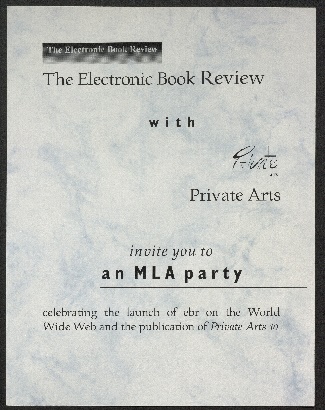
Printed on thick, poster-like paper, this invitation commemorates the launch of ebr on the World Wide Web. The party took place at alternative venues in Chicago—including art galleries and music spaces—emphasizing the journal’s off-mainstream, experimental roots in both literature and cultural space.
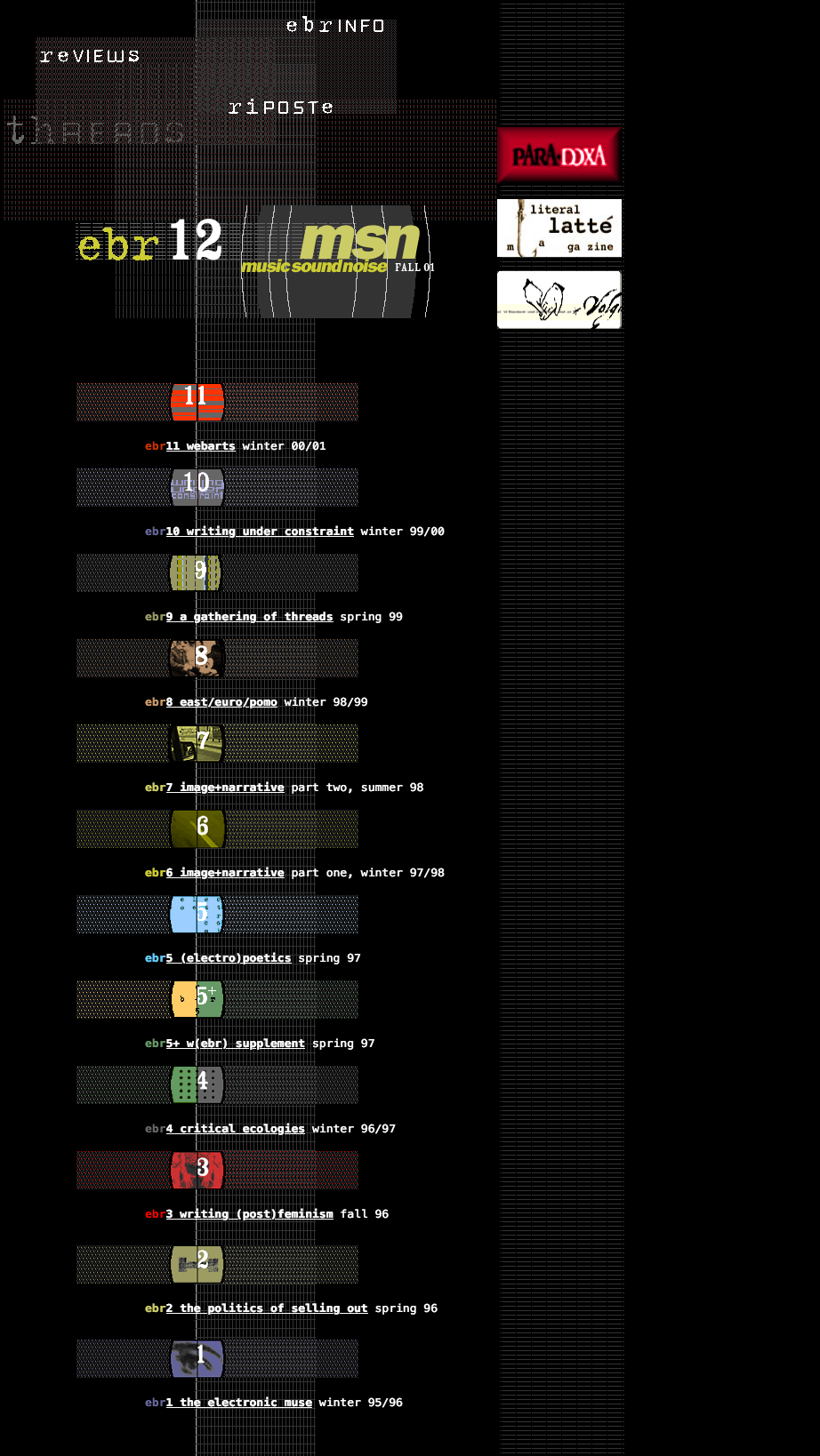
This list itemizes the titles of ebr’s first 12 issues, beginning with “The Electronic Muse” and ending with “Critical Ecologies.” It provides a concise record of the journal’s editorial evolution during its initial, thematically organized phase under the Alt-X domain (1995–early 2000s).

This screenshot of the ebr Weave interface demonstrates how essay relevance is determined not by inherent document semantics but by editorial activity and discourse networks. It exemplifies an editorial, rather than algorithmic, approach to information retrieval, where essays rise to prominence through renewed curatorial engagement and thematic mixing
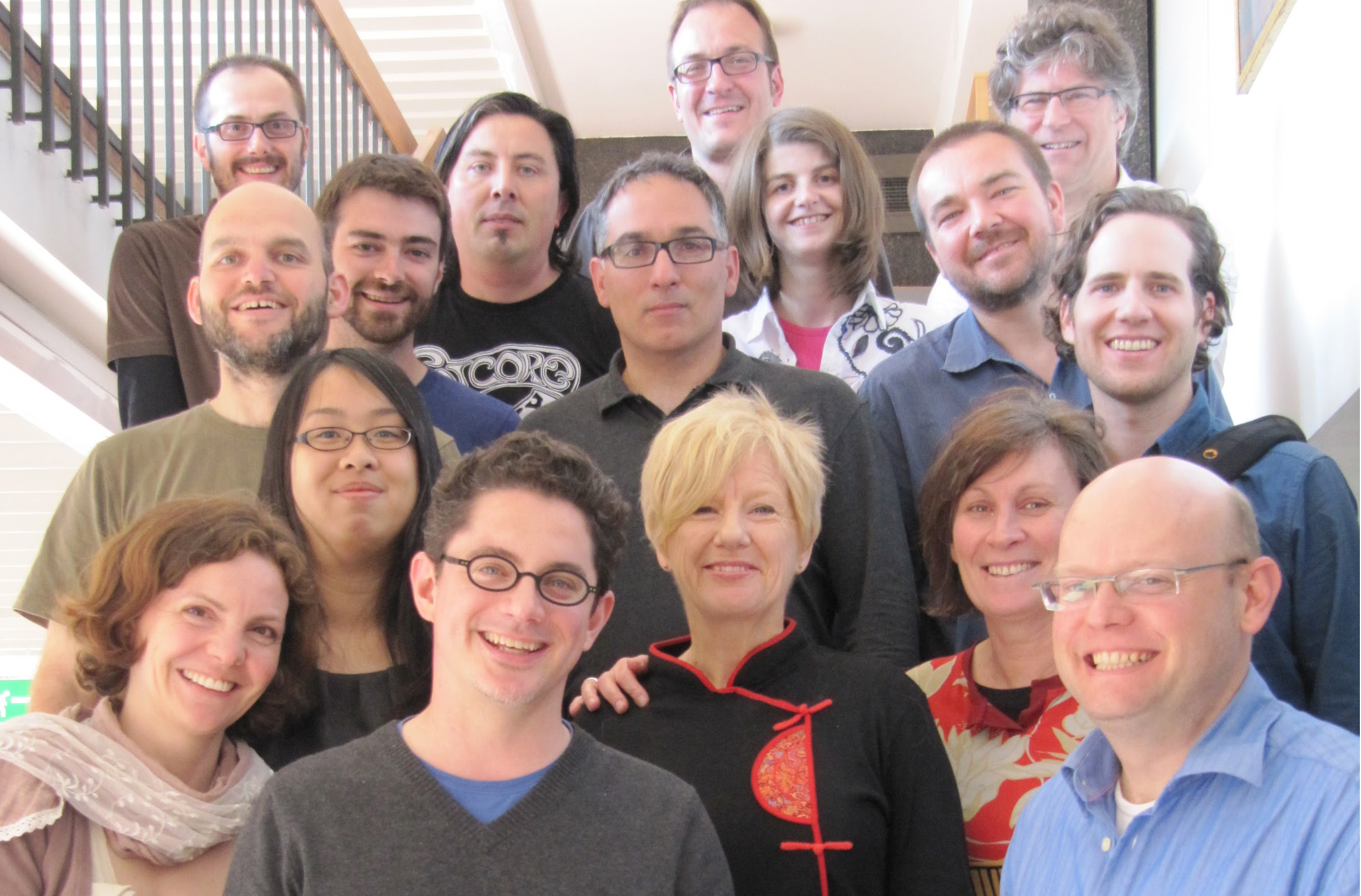
2011 meeting the CELL project, which tracked literary-critical discourse across networked sites. This initiative was co-developed with ebr’s editors as part of an effort to interlink born-digital publications and critical writing platforms.
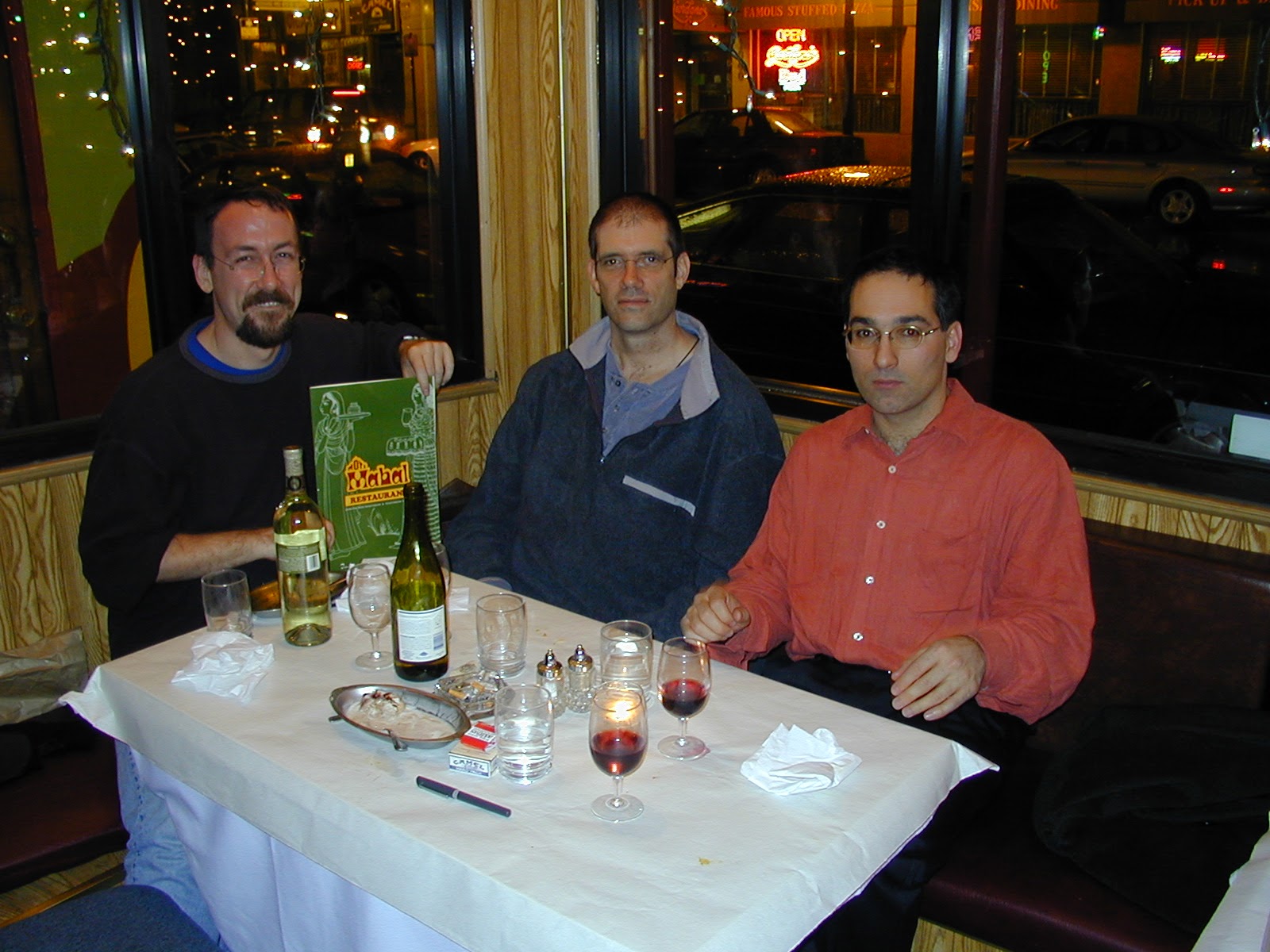
A candid snapshot of a key 2000 meeting in Chicago featuring Ron Heintz, Joseph Tabbi, and Rob Wittig—three influential contributors to ebr’s editorial infrastructure and digital strategy.
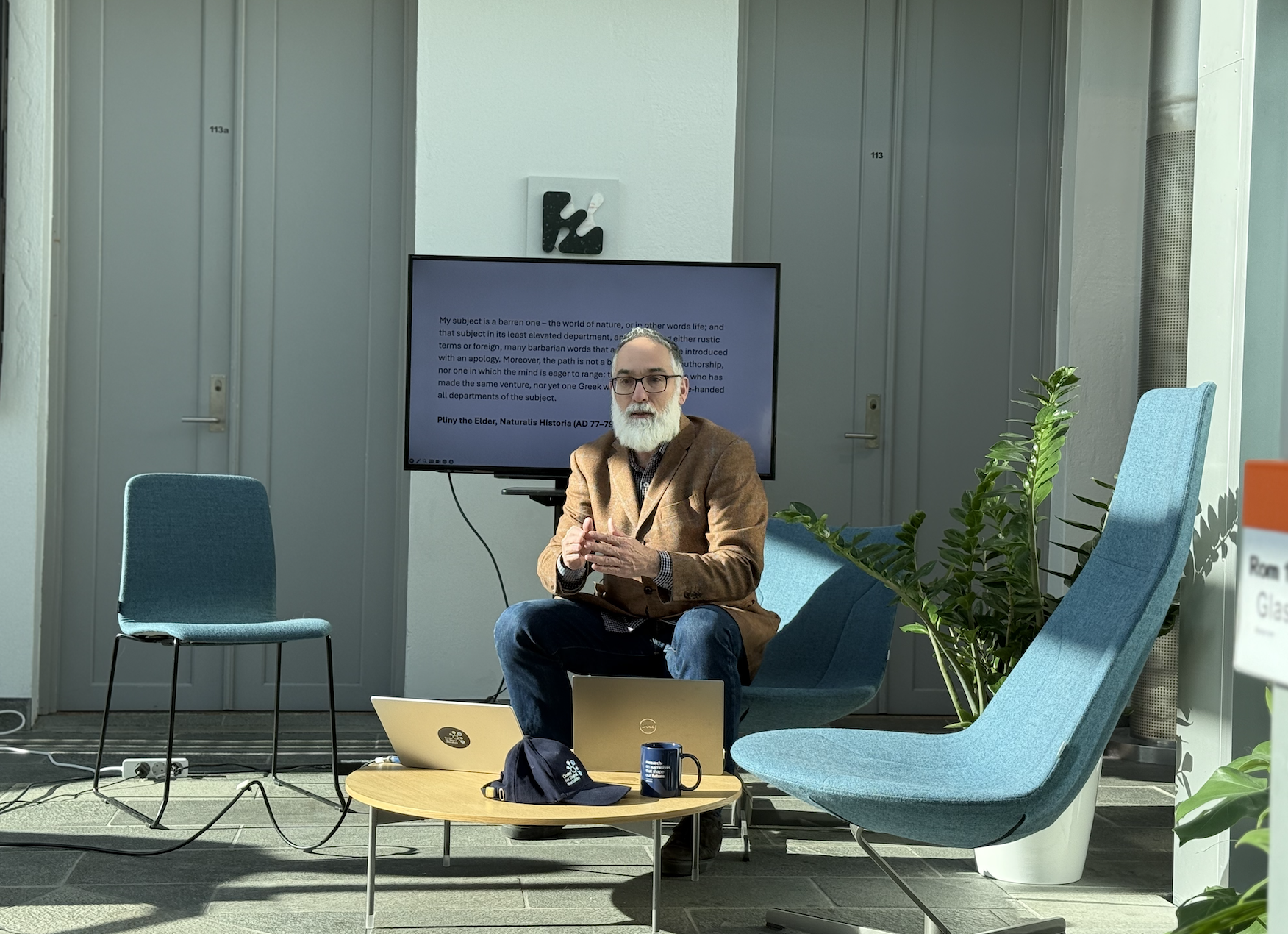
Joseph Tabbi at the Center for Digital Narrative (2025)

2000 editorial retreat with Joseph Tabbi, Mark Amerika, and Scott Rettberg. These early planning sessions were often held at a pub in Chicago.
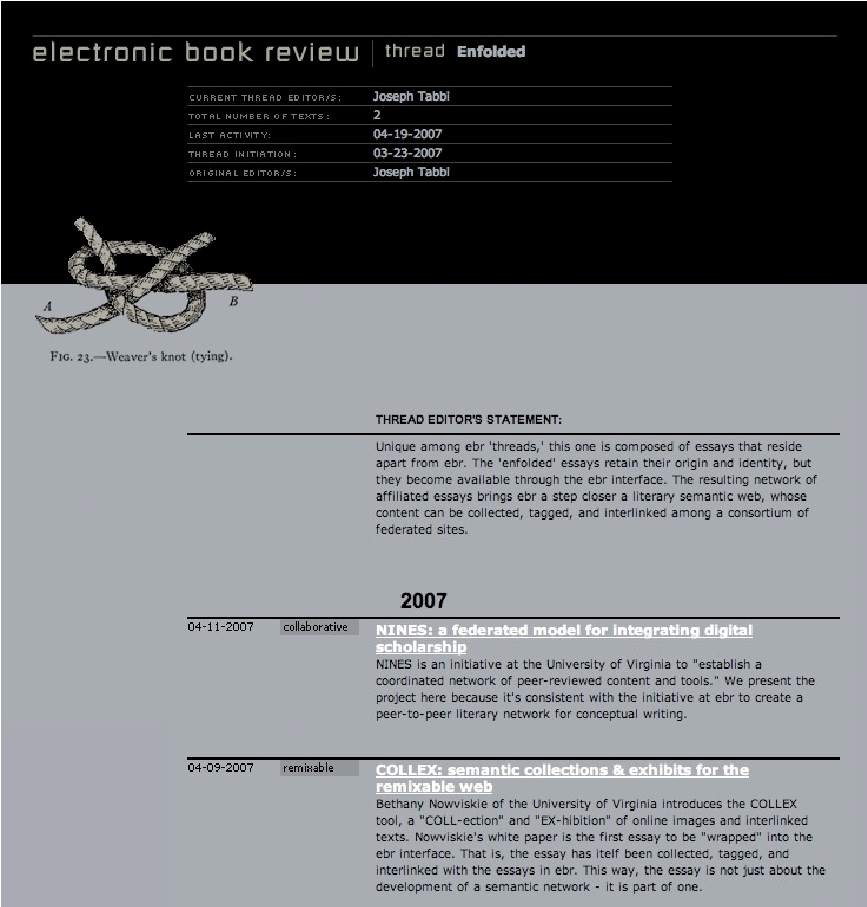
"Unique among ebr 'threads', this one is composed of essays that reside apart from ebr. The 'enfolded' essays retain their origin and identity, but they become available through the ebr interface. The resulting network of affiliated essays brings ebr a step closer to a literary semantic web whose content can be collected, tagged, and interlinked among a consortium of federated sites."

Here we see the glossing interface, which allows users to annotate individual essays at the paragraph level. Glosses personalizes the reading experience by linking commentators directly to textual segments, fostering deeper engagement between reader and document.
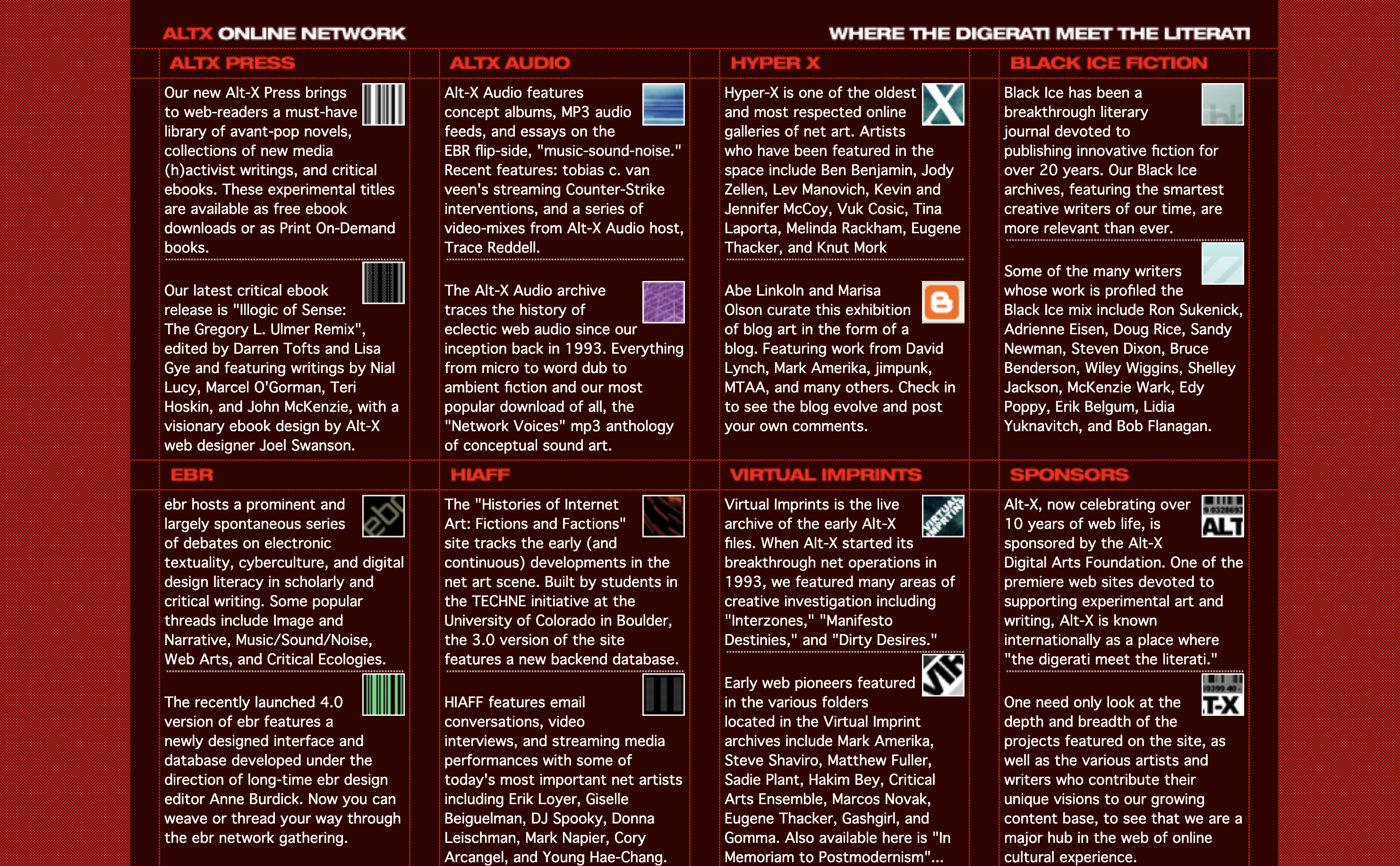
In 1995, Alt-X, a hybrid zone of experimental literature, media art, and avant-garde publishing, hosted the first issues of electronic book review, offering a space where literary innovation and network culture could collide.
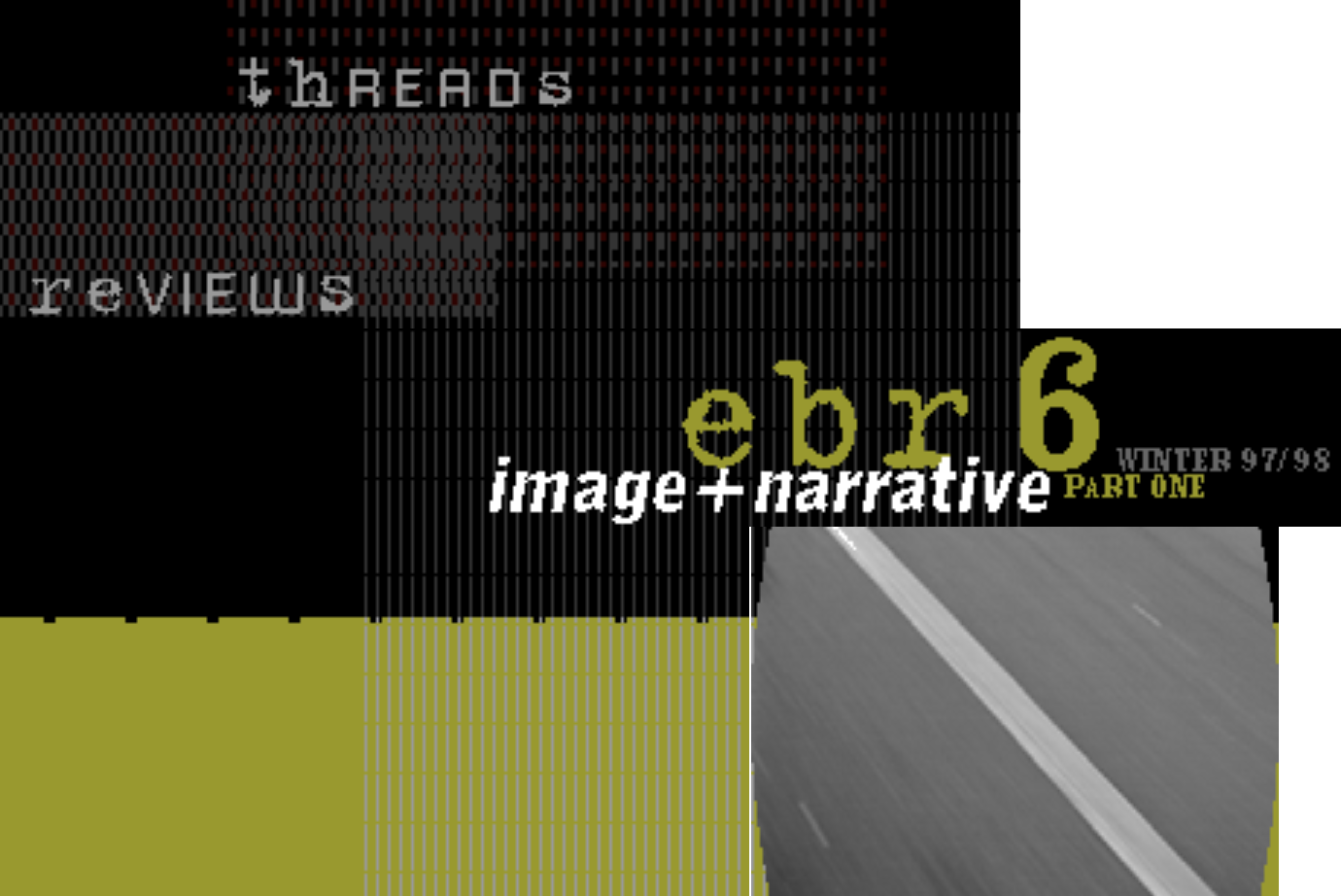
ebr vol. 6 interface,
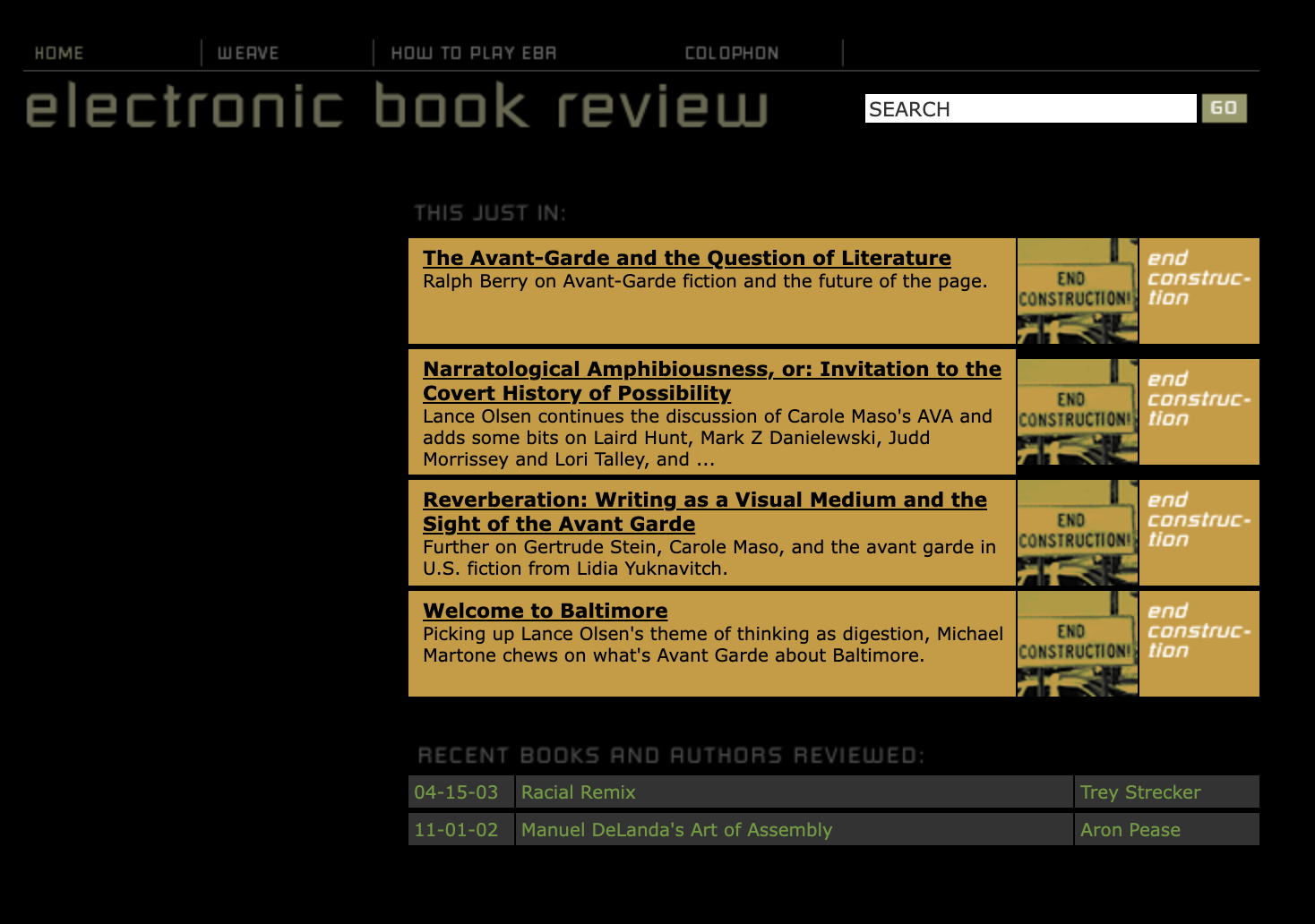
2001 ebr interface.
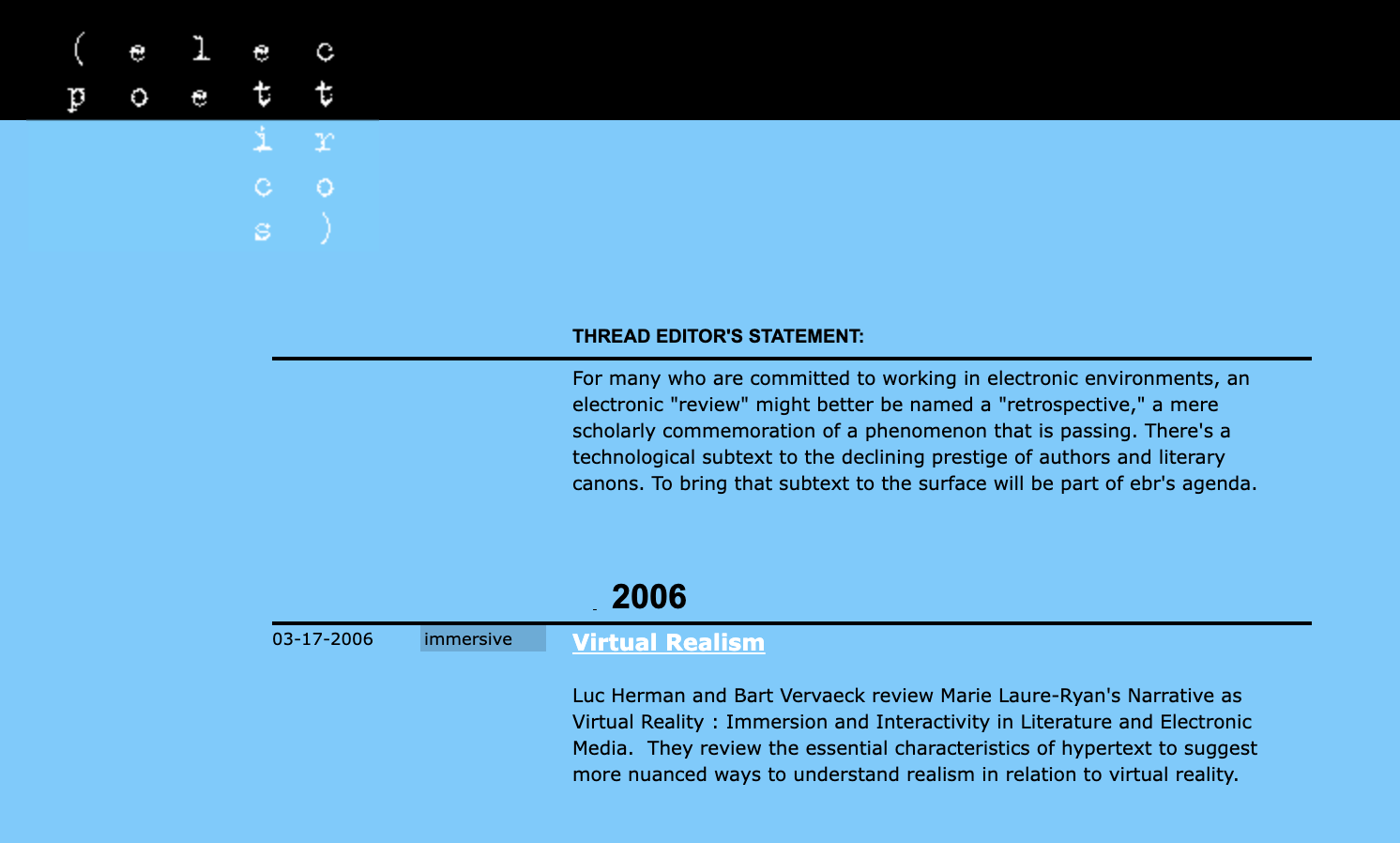
ebr electropoetics thread.
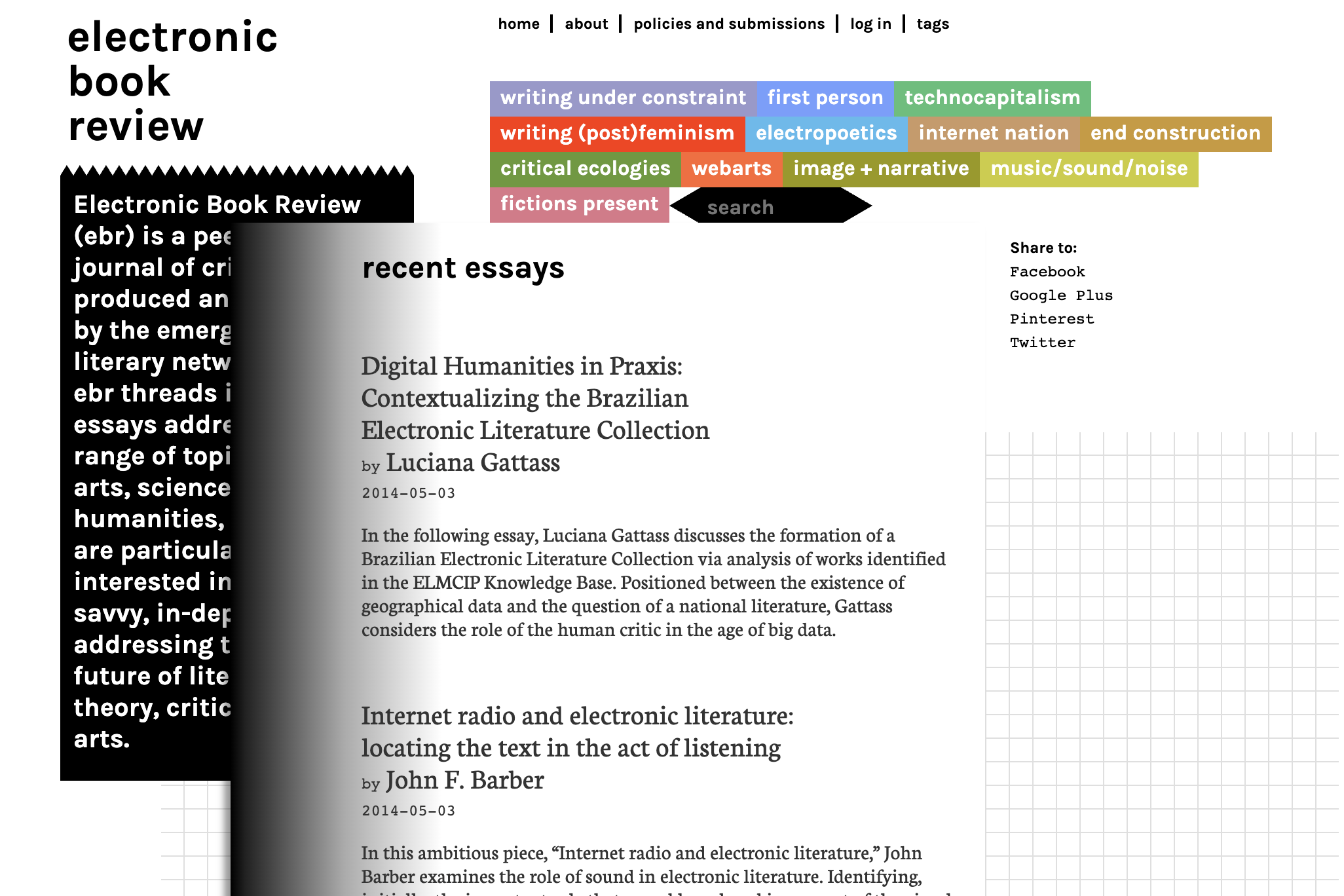
ebr Drupal interface.
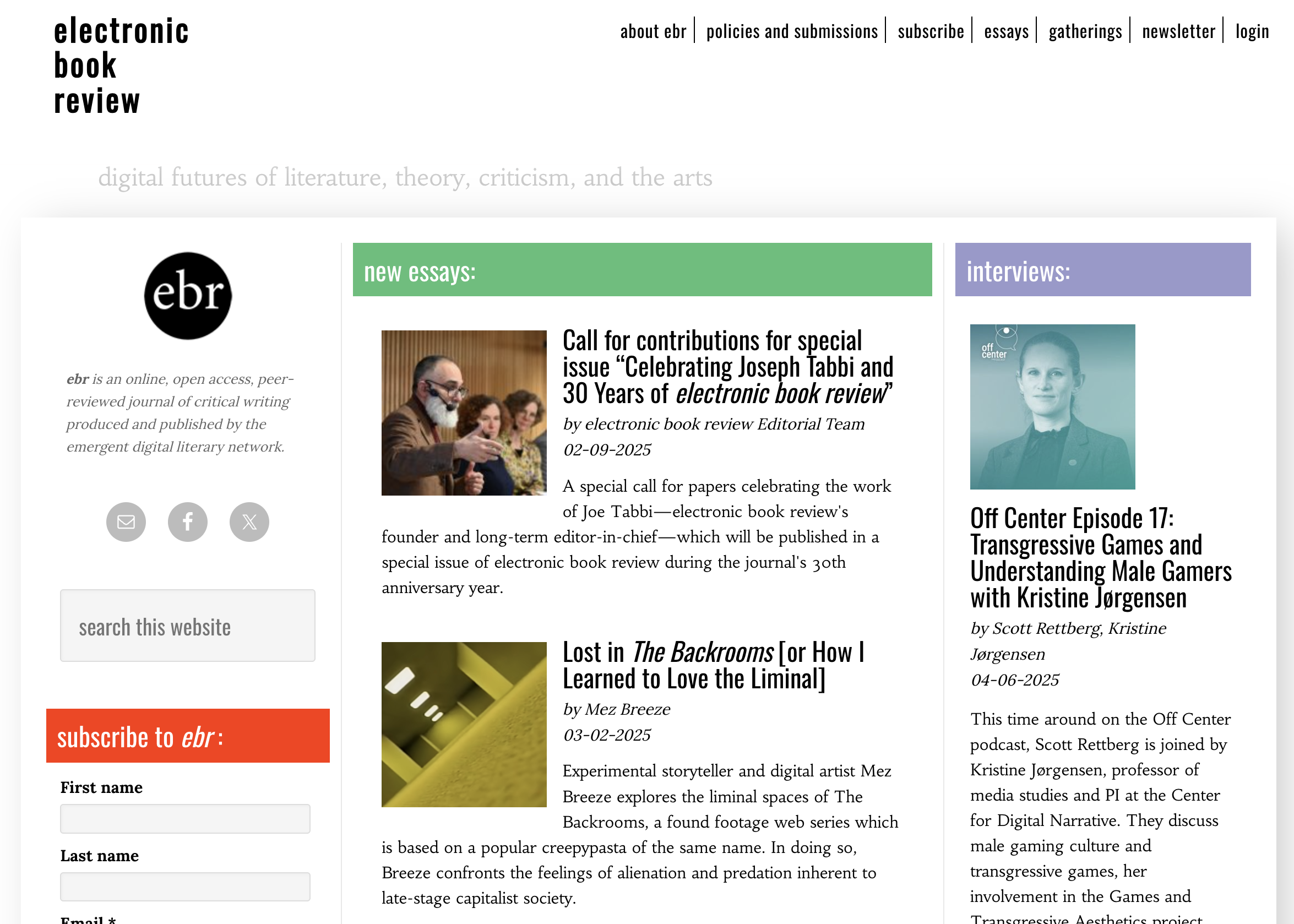
In 2018, Will Luers becomes Managing Editor and Information Designer, migrating ebr from Drupal to WordPress and with Sharon Oiga, redesigns the site interface.
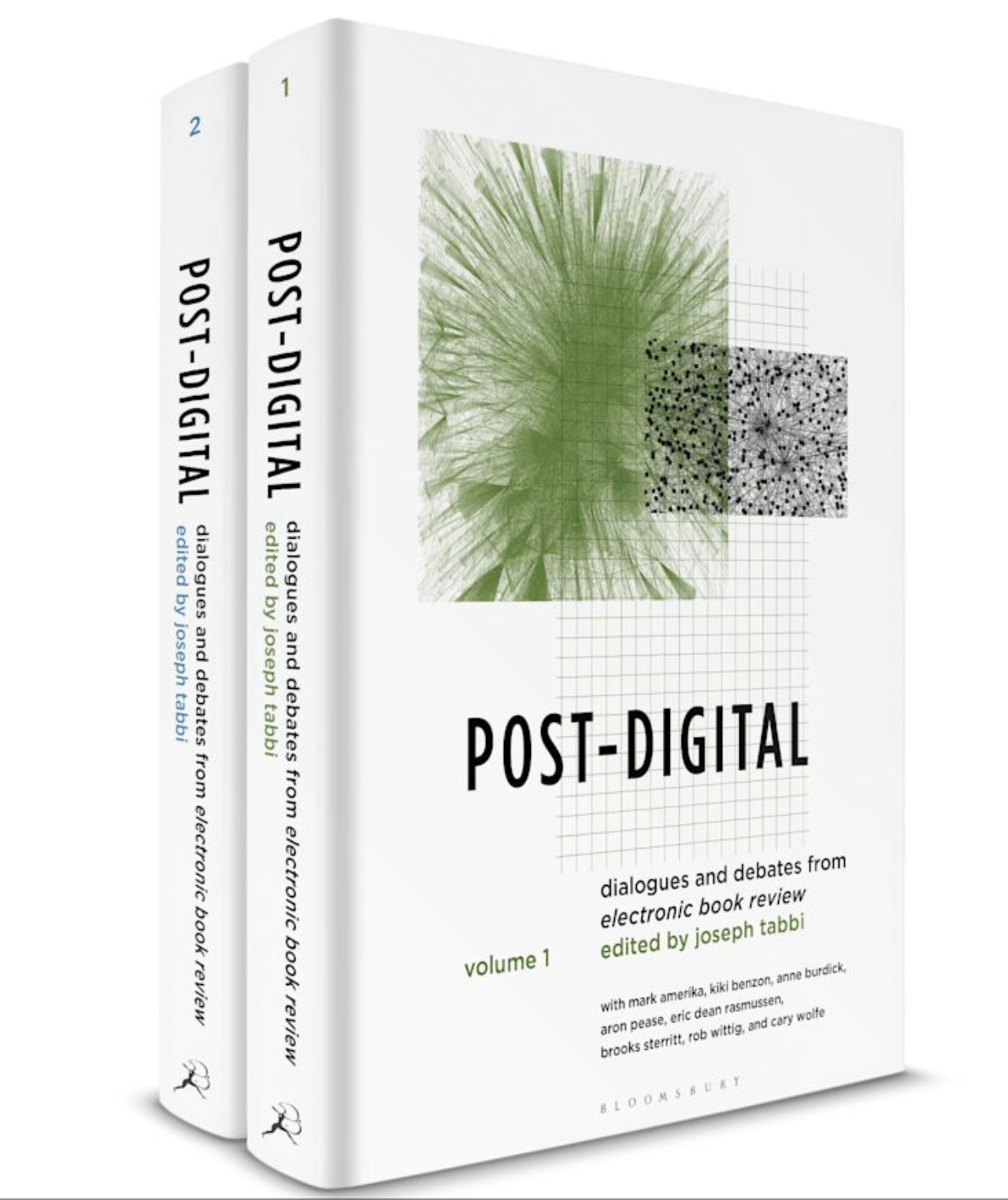
Joseph Tabbi, working with contributors to ebr, publishes Post-Digital: Dialogues and Debates from electronic book review, a print collection archiving two decades of essays. This marks a shift to curating ebr’s archive for new critical audiences.
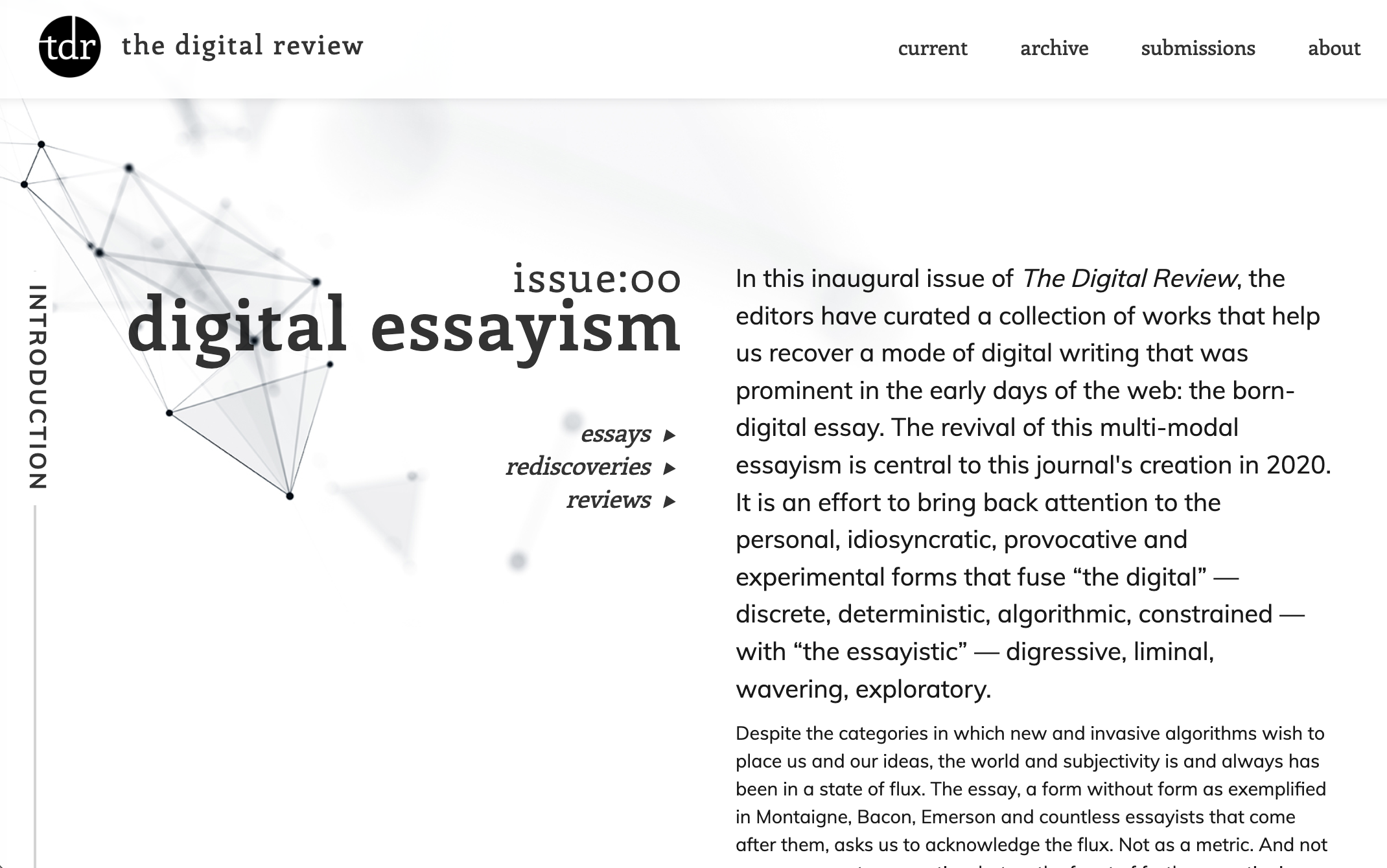
ebr's sibling publication The Digital Review launches: "Issue 00: digital essayism" with Will Luers as editor and the ebr team as co-editors. Each following issue has a different editor and diffrent editorial focus.
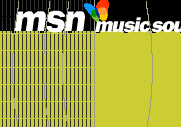
Gif animation from ebr vol. 12.
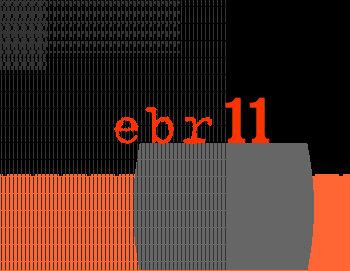
Gif animation from ebr vol. 11.
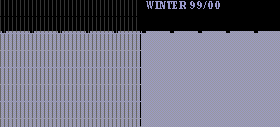
Gif animation from ebr vol. 10.
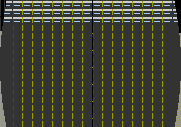
Gif animation from ebr vol. 9.
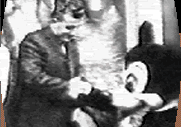
Gif animation from ebr vol. 8.
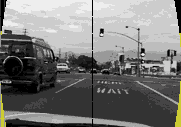
Gif animation from ebr vol. 7.

Gif animation from ebr vol. 6.